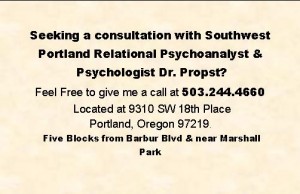What happens in Psychoanalysis or Pychodynamic therapy?
“I left a very painful relationship two years ago, and I am realizing that it affected me more than I thought. I was taken advantage of.”
“I seem to always end up losing relationships. They don’t last very long.”
“I freeze when someone expresses dissatisfaction with me.”
“I work too hard to please others and avoid conflict.”
“I am not really sure how to develop a healthy committed relationship with another person.”
“I usually blame myself for relationship problems.”
Difficult circumstances or feelings can lead to a narrowed limited experience of life, or they also have the potential to be transformative to a new more emboldened and openness to life. The audio below likens this process to tree roots effecting the trees.

Contemporary relational psychoanalysis is a unique proess that simultaneously decreases your vulnerability to those “Stuck” parts that continue to haunt you in your feelings and relationships because of past bad experiences. At the same time, contemporary relational psychoanalysis expands your capacity to relate freely and connect freely to others, while also being able to preserve your own good sense of yourself. This is what we call expanding the relational mind.
We have many sides to ourselves, many beliefs about ourselves and our relationships, and often may feel pulled in many directions. Often these different sides or beliefs are not always yielding to a rational understanding of things. Cognitive therapy does not always work, because there may be emotions within us, more powerful than the evidence of reasoning, that can block our growth. In psychodynamic therapy, I am interested in helping patients understand and change the conflicting and often less understood sides of themselves that contribute to their personal relationship problems. During psychodynamic therapy, these conflicts, including fear or avoidance of anger or hostility, self-sabotage or self-attack, fear of intimacy or closeness, or lack of boundaries between ourselves and others become clarified and gradually shifted within the emotional reeducation process of the therapy.
Research examining why people change in relational psychoanalytic therapy, finds evidence that “It is though the relational process of being in a healthy relationship with another person that we receive an emotional, rather than a cognitive reeducation that allows us more freedom in relating to others, more freedom from our fears and anxieties, and more courage to be seen by others.” Sometimes it is not the obvious content of a therapy session as in cognitive therapy which brings about change or growth. Rather, it is the relational process of having a safe supportive counseling relationship which can help you to explore new ways of being, re-live traumatic experiences, realize a new way of doing relationships, or gain more inner strength to carry on your daily life.
Personal changes in our relationships with others come through what is broadly known as procedural knowledge, which is the implicit knowing about what to do, think, and feel in a specific relationship context. This knowing is not conscious, so it it not easily shifted by cognitive therapy. It simply operates ouf of awareness. This has been called implicit relational knowing. It is a bit like learning the procedure of a sport like tennis, or learning to ride a bicycle through actual practice and coaching in the midst of the actitivity, rather than just being giving advice about the activity.
Often the patterns that give us problems were there even before we could talk, so they are less amenable to change via reason, but more changed by the presence of a good relationship. We are hard-wired for relationships, so it is only in a supportive relationship like therapy that we can learn to do relationships better. Alan Schore, a leading neurophysiologist has actually looked at how the brain actually changes in relationships..(For More information See a youtube discussion by Alan Schore of this process which is important in learning to do relationships differently.)Psychodynamic researchers call these shifts or changes in ourselves in therapy as occurring in the “now moments” It is in the “now moment” that change occurs–the sacrament of the present moment.It is the present moment in actual relationships in all its richness that changes and moves us.
There is also research support for the effectiveness of psychodynamic or psychoanalytic therapy. “Effect sizes for psychodynamic (psychoanalytic) therapy are as large as those reported for other therapies that have been actively promoted as “empirically supported” and “evidence based.” In addition, patients who receive psychodynamic therapy maintain therapeutic gains and appear to continue to improve after treatment ends. Jonathan Shedler (American Psychologist, 2010)

